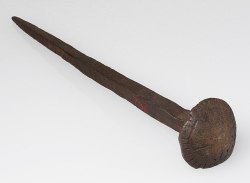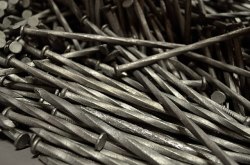What Nails To Use For Wooden Floors
When you think of machines you see around you every solar day, you probably think near your auto, computer, or household appliances. Withal, the world is total of simple machines. One simple automobile in particular, the inclined plane, shows upward a lot. For instance, call back of the humble nail. If you lot are a woodworker or fifty-fifty a homeowner you probably accept bags of them. They certainly are all around yous if yous are indoors and peradventure even if you are outdoors right at present. Nails have been the fastener of choice for a very long time and they are a course of a wedge which is a type of inclined plane.
What else can you say about nails? Turns out, at that place is a lot to know. Similar other fasteners, there are nails for very specific purposes. There are fifty-fifty nails with two heads and — no kidding — nails with two points. Exactly what kind of nail you need depends on what yous are doing and what'southward important to you.
Terminology
Just about every nail has a head, a shank, and a point. Yous tin probably judge where each of those terms mean. However, it is the details that affair. Some nails have very specific shapes for the head and the shank to work in item applications.
There are many variations on each of these parts, though. Heads tin can be flat or cupped. There are countersink heads and textured heads known as checky flatheads. Equally for the shanks, most nails are smooth, but some are twisted to forbid bending or accept rings or barbs in them to grip the wood ameliorate. Even the point blueprint is important. Edgeless points are less likely to divide wood. Diamond-shaped points are the most mutual and in some applications, the point is made longer than normal. Experienced carpenters may blunt a boom's point a petty by hit it with a hammer to reduce the chance of splitting the forest.
Size is 1 place where the terminology isn't every bit easy to figure out. In most of the world, nails get by a metric size. But non in the United States. Here, we use a system based on an obsolete English language measure. Nails are sold in "penny" sizes that vary based on the type of nail to some degree. A 10 penny nail, for example, is 3 inches long, merely the diameter of the shaft and caput depend on the type of smash. Most of the remainder of the globe uses a length and diameter in millimeters.
You oft run across "10 penny" written equally 10d, by the way, where the d stands for denarius, which was an erstwhile Roman money similar a penny. Odd, aye, and maybe that's why everyone else went metric.
History

Every bit you might expect, nails are ancient engineering science. Even the aboriginal Romans used nails and even invented the hook hammer. From at least that time to the 1800s, people formed nails from iron or statuary by paw — manifestly, the ancient Egyptians used wooden pegs instead. Blacksmiths made nails every bit did nailors. You showtime with a heated foursquare iron rod and hammered the sides to form a point. Later on reheating and cutting off, you put the hot blast into a hole in an anvil to hold information technology and hammered out the caput. The resulting smash has a decidedly foursquare shank, dissimilar the typical round shank you'll observe today.
Nails were difficult to produce and, thus, expensive. This was specially true in far-flung areas like colonial America. There, people would sometimes burn down an abased business firm — fifty-fifty if they were the ones abandoning it — to recover the nails from the ashes. Large structures often didn't employ metal nails but used carefully fitted wooden parts secured with wooden pegs.
Because nails were valuable, families sometimes had the requisite equipment in their homes or farms. When they had fourth dimension — often at nighttime or in bad weather — they would produce nails for their own use or to trade with others. Apparently, even Thomas Jefferson was known to make and sell nails, sadly, using enslaved farm labor.
Of course, making a boom in the twelvemonth 1033 was a lot dissimilar than in 1733. Some equipment — especially slitting mills — fabricated the product of nails easier, fifty-fifty though information technology was withal labor-intensive.
However, throughout the 1700s, several people created machines to cutting nails directly from iron sheets. These cut nails were cheaper, although wrought nails were still harder and used in things like horseshoes for quite some time. Withal, cutting nails did button out wooden pegs in framing structure and there are still a few niche uses for them today.
In the 1800s, though, a new way of making nails started to become popular and it is used today for most nails you'll meet. Using the same process used to course wire, lengths of wire were cut and formed directly into nails. A blade cuts the point and a pressure process forms the head. In 1892, more steel-wire nails were produced in the U. S. than cut nails. By 1913, 90% of all nails were wire nails. Finally, nails were a inexpensive commodity item you wouldn't burn a house downward to recover.
Mod boom machines, like the one in the video below, can create a tremendous number of nails in a brusque period of time. No wonder nails are inexpensive.
As a side note, woodworking in ancient Asia used a fascinating but nail-free technique. That region had advanced metallurgy, of course, only they didn't really need nails.
Common Nails
Actually, there is a specific type of nail known every bit a common nail, and information technology is, of form, what you commonly discover. These nails accept heavy polish shanks and a wide caput. The point is shaped like a diamond. These are cracking for many purposes. Framing nails are like but have thinner shanks. Joist hanger nails use hard materials and have ridges along the shank to increase their belongings power. Siding nails are besides common and usually take thicker shanks for hammering through hardwood.

Smaller nails are often known as brads or finishing nails. Both are unremarkably very skinny both to be unobtrusive and to avoid splitting fragile material. Brads typically have a small head and finishing nails are beefier but accept heads made to be unobtrusive. In some cases like model shipbuilding, small nails are lilliputian more than sharpened wire that y'all drive in with a nail driver.
Covering nails tend to take very large heads to prevent roofing sheets from trigger-happy. They likewise employ materials that will be resistant to the weather. Some roofing nails also include a washer to help seal the roof confronting a leak at the smash hole.
Nails that are meant to go into softer materials like drywall tend to take a pattern of ridges or barbs on the shank or some other method to make the shank grip the material better. Weatherstripping nails have the same system but are usually made of very weather-resistant material. You'll also find ridges in nails meant to hold panels and some other types of nails.

Yous'll occasionally see nails with a twisted shank. This makes it harder to bend the blast and will cause the smash to thread into hardwood. Spiral shank nails and flooring nails accept shanks similar this as do another specialty nails.
In that location yet more specialty nails. Upholstery nails that have large decorative heads. Nails for shoes. Tacks that as well have big heads, some for carpeting. There are nails with T-shaped heads and nails optimized for concrete.
And then in that location are the strange nails. There are still places where cut nails are used for decorative or restoration reasons. Cutting nails as well find use in masonry where they are made out of very strong materials and have a tapered shank to help reduce spalling — that is, chipping away at the concrete surface.

One of my favorite nails is the duplex nail that yous use when you are edifice something temporary like a scaffold or a concrete form. The nail has a normal head only as well another head a small distance down the shank. When you are building something you know y'all'll take apart later, you hammer downward to the lower head and the rest of the shank sticks out waiting for y'all to pull information technology out when the time to detach comes.
Materials and Coatings
Adding to the complexity of the humble nail is the cloth it is made from. There are hot-dipped galvanized nails and stainless steel nails. Some nails are fabricated of materials like contumely or copper. Some are coated with "cement" — meaning a glue — for belongings power. Some nails even have a coating that melts from the hammering friction to glue into the wood.
Of grade, steel isn't but 1 material. Some nails are made of relatively balmy steel and others use harder steel with higher carbon content. Information technology all depends. Mild steel is fine for forest, only nails meant for physical are likely to apply stronger materials.
Or, Become Screwed
Of class, you could use screws instead of nails. When I was a child, people didn't like screws in woods because it was faster to hammer in a boom, merely screwdrivers were slow. With power screwdrivers, this isn't a big bargain anymore, but I guess nail guns are fifty-fifty faster. The video below covers a lot of proficient data about screws versus nails.
At that place was a day when nails were a common function of circuit breadboard and you used a real staff of life board. Now, we are more probable to see them in a very different context.
Source: https://hackaday.com/2022/03/15/tech-in-plain-sight-tough-as-nails/
Posted by: dickensevervall.blogspot.com


0 Response to "What Nails To Use For Wooden Floors"
Post a Comment